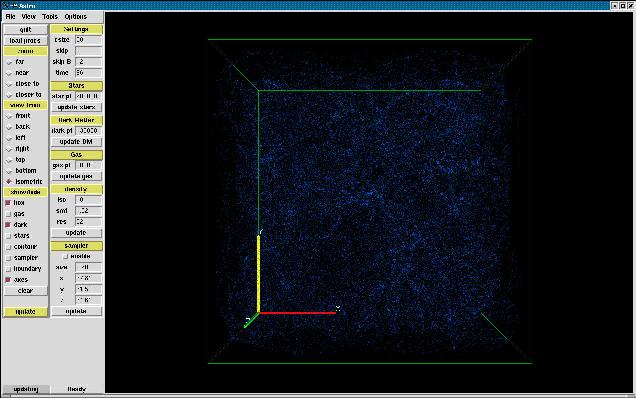Contents
Previous
Next

A Multi Dimensional visualization and analysis toolkit for
astrophysics
Version : 0.0.3
Author(s) : Fulvio Buonomo (buonomo@cineca.it)
License : Free
Website :
http://www.cineca.it/astromd/
Disk space required for installation is 29.18 Mb
After the package is installed it can be accessed using the command
/opt/lfa/startAstroMD
A shortcut will be installed in the KDE/GNOME desktop menu system,
as an entry in the Astronomy submenu
Summary
AstroMD is a visualization package built in collaboration by CINECA
(Bologna - Italy) and the Astrophysical Observatory of
Catania (Catania - Italy), with the specific object of supporting
visualization and analysis of astrophysical three dimensional
structures. Astrophysical data, in fact, have peculiarities that
make them different from data coming from any other kind of
simulation or experiment. Therefore they require a specific
treatment. These characteristics can be summarized as follows:
- several different physical species are treated. For example,
cosmological simulations consider both baryonic matter and dark
matter. Dark matter is usually described by N-body algorithms,
while baryons have a fluid-dynamics description (either Eulerian or
Lagrangian). Further components, like stars or different chemical
species, can be introduced and followed in a specific way. These
different species requires different types of visualization. Dark
matter needs particles position or velocity rendering while baryons
require mesh based visualization. Furthermore particle associated
quatities, like the mass density or the gravitational potential,
require their calculation and visualization on a mesh.
- Simulated structures have a fully three-dimensional distribution.
Therefore it is necessar to have a clear 3D representation and
efficient and fast tools of navigation, selection, zoom and the
possibilty of improving the resolution and the accuracy of
calculations in specific, user-selected, regions
- Evolution can change dramatically the properties of the simulated
objects and the information that can be retrived, therefore it is
important to control efficently sequences of time-frames.
Moreover, in order to build a widely used product it was necessar
to use a low cost software portable on a number of different
platforms. We have chosen to use the Visualization Toolkit (VTK) by
Kitware. VTK is an open source, freely available software
system for 3D computer graphics, image processing, and
visualization. It includes a C++ class library and several interpreted
interface layers. VTK has been ported on nearly every Unix-based
platform (e.g. Linux or IRIX) and PC's (Windows NT and
Windows 98). The design and implementation of the library has been
strongly influenced by object-oriented principles.
The graphics model in VTK is at a higher level of abstraction than
rendering libraries like OpenGL or PEX. This means it is much
easier to create useful graphics and visualization applications. In
VTK applications can be written directly in C++, Tcl, Java, or
Python. Using these languages it is possible to build powerful,
fast and portable applications.
VTK supports a wide variety of visualization algorithms including
scalar, vector, tensor, texture, and volumetric methods and
advanced modeling techniques. It supports stereographic rendering
and can be used for virtual realty visualization. Furthermore,
being easily extensible, the system allows ad hoc implementation of
specific modules.
All the features described above are integrated in the AstroMD
package. Furthermore efficent manipulation and analysis tools,
like smoothing of the particle masses on a mesh or calculation of
the power spectrum and correlation functions, are parts of the
basic functionalities.
AstroMD has also stereographic rendering capabilities, which makes
it usable for immersive visualization (presently implemented
at the Virtual Theater of CINECA). This completes and improve its
capabilities in the representation of three dimensional data
set.
Screenshots

Contents
Previous
Next

